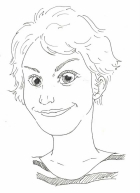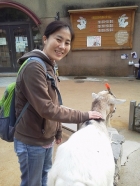Colorful Culture
As a world without colors would be extremely boring, we are luckily able to perceive various different colors that enrich our environment. Recently, Keiko Ishii and colleagues found that the colors we prefer and use for our paintings vary systematically across cultures. But that doesn’t mean that tomorrow’s multi-cultural world is becoming black-and-white or grey, rather there is hope that it will become even more colorful than it is today. In this post, we will illustrate how individuals and cultures engage in mutual construction and thus enhance variety.
While there is a debate about the way that globalization is influencing the shape of the world from being figuratively “flat” (Thomas Friedman), “spiky” (Richard Florida), or “round” (John Gray) one thing is for sure: its color is neither grey, nor black-and-white. Admitting that globalization is making the world more interconnected, and that all kinds of exchanges are easier than ever (i.e. the flat world in Friedman’s view), the environment still has a strong influence on peoples’ lives. Similar to the potpourri of colors that enriches our immediate surroundings, a bouquet of cultures colors the world. There is a large amount of research exploring how our cultural surroundings influence us. This process is however better thought of as a circle than a one-way street. While we are influenced by our surroundings, we all, in turn, also contribute to shape our environment. By doing so, we configure our cultural context (Figure 1).
One of the ways in which the interaction of individual and culture has been studied is by examining the actual things and events that surround us in our daily lives (Morling & Lamoreaux 2008). Aspects of the media (TV ads, internet blogs, magazine articles, textbooks), art (paintings, lyrics, novels), religion, physical gestures and management practices have for example been found to mirror culture-specific values and beliefs, influencing us in our thinking and behavior. The 2000 and 2002 Olympic press coverage, for example, has been found to describe athletes’ agency referring more to internal attributes (e.g. positive personal characteristics) in the West, and on external factors (e.g. social support) in the East (Markus et al., 2006). These findings thus describe one direction of the circle. Recent research has however shown that cultural products do not only passively influence us, but we also actively shape and select them. By doing so, cultural values are maintained and retransmitted to others (Ishii, Miyamoto, Rule, & Toriyama, 2014). Understanding this process allows us to see the other half of the circle better.
Keiko Ishii and colleagues found that an emphasis on the cultural value of harmony, which is a value that is typically highly endorsed in East Asian cultures, leads individuals to prefer and produce less intensive colorings (e.g. whitish and pastel colors and low color contrasts). Contrarily, striving for uniqueness, which is a common value in the West, is reflected in preferences for, and production of, paintings that are rich in color contrasts and high in intensity (Figure 2). Preferences for unique or harmonious colorings in Asian-Americans even varied according to how much they identified with their heritage (an Asian culture) or host (American) culture, respectively.
In line with other cross-cultural studies, which show that cognitive differences are transmitted through
socialization (e.g., Senzaki & Masuda, 2013), the researchers found that even four to six year-old children produce physical objects in a way that reflects the values and ideas of their own culture.
Moreover, the children’s paintings were preferred more by own-culture adults than by other-culture adults (Figure 3). Furthermore, parents were likely to provide feedback to their children that fit with own-culture values, suggesting that children acquire not only cultural values, but color preferences through
socialization as well.
These recent studies provide initial evidence that people perceive, evaluate and produce physical objects in a culture-specific way and maintain preferences accordingly. We play an active role in supporting our own cultural values and hence contribute to the maintenance and reinforcement of our cultural systems. In doing so, we play an active role in sustaining the world to stay as colorful as it is. Moreover, instead of drifting towards homogeneity, the clashing of different cultural values leads to changes in preferences that allow for new aspects, ideas and judgments to arise, and be transferred from generation to generation. Similar to an artist mixing different colors to create a new tone, multicultural exposure adds new concepts to the repertoire of routines that determine our daily life, thus providing action alternatives. So, retrieval and integration of aspects from different cultural sources generates creative ideas. Therefore, we do not need to fear a grey world. Evidence suggests that the global world of tomorrow might be even more colorful than today’s.
References:
Ishii, K., Miyamoto, Y., Rule, N. O., & Toriyama, R. (2014). Physical objects as vehicles of cultural transmission: Maintaining harmony and uniqueness through colored geometric patterns. Personality and Social Psychology Bulletin, 40, 175-188.
Markus, H.R., Uchida, Y., Omoregie, H., Townsend, S.S.M., & Kitayama, S. (2006). Going for the gold: Models of agency in Japanese and American contexts. Psychological Science, 17, 103-112.
Morling, B., & Lamoreaux, M. (2008). Measuring culture outside the head: A meta-analysis of individualism- collectivism in cultural products. Personality and Social Psychology Review, 12, 199-221.
Senzaki, S. & Masuda, T. (2013). How do European-Canadian and Japanese parents pass on culturally unique patterns of attention to their children? The role of parent-child narratives during the cultural transmission process. Poster presented at the 14th Meeting of the Society of Personality and Social Psychology, New Orleans, Louisiana, USA.


